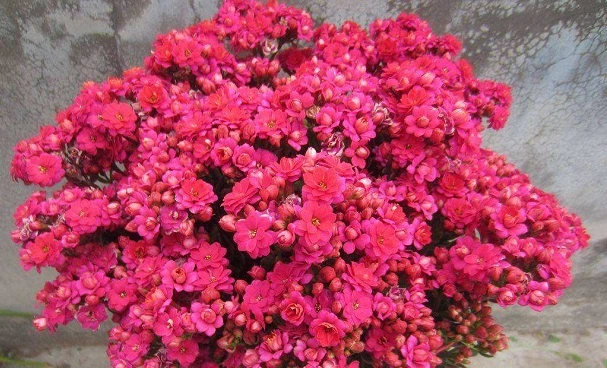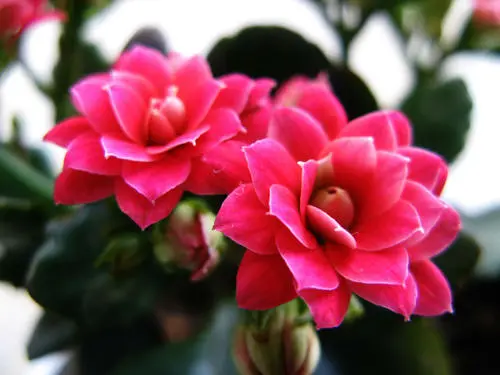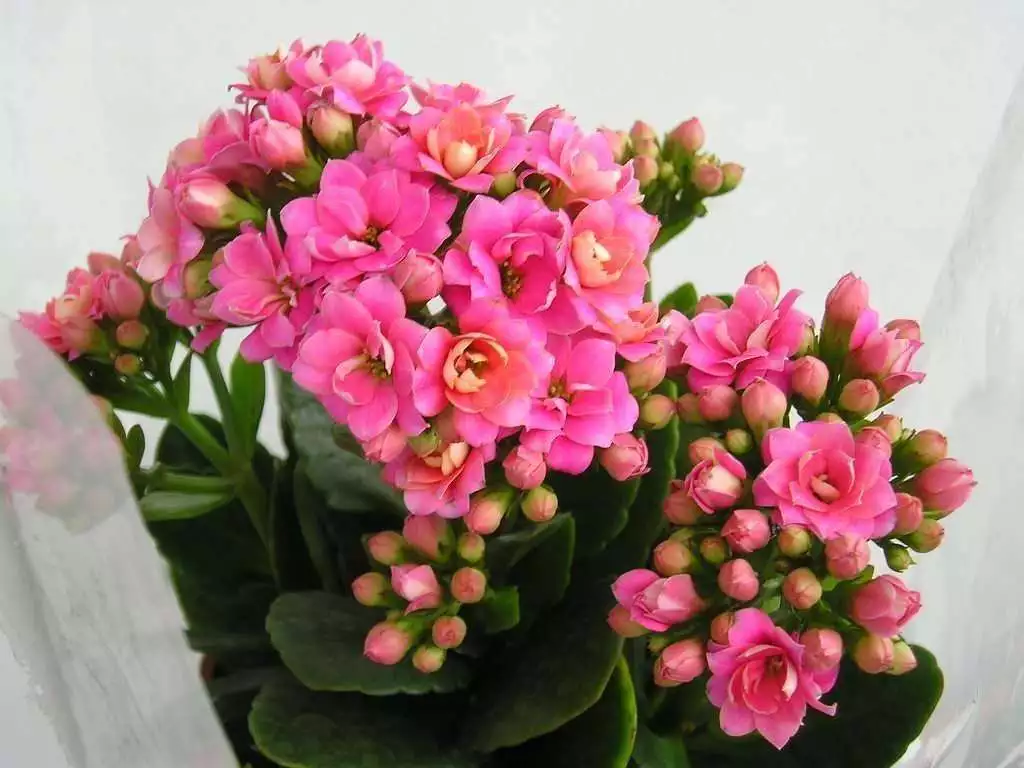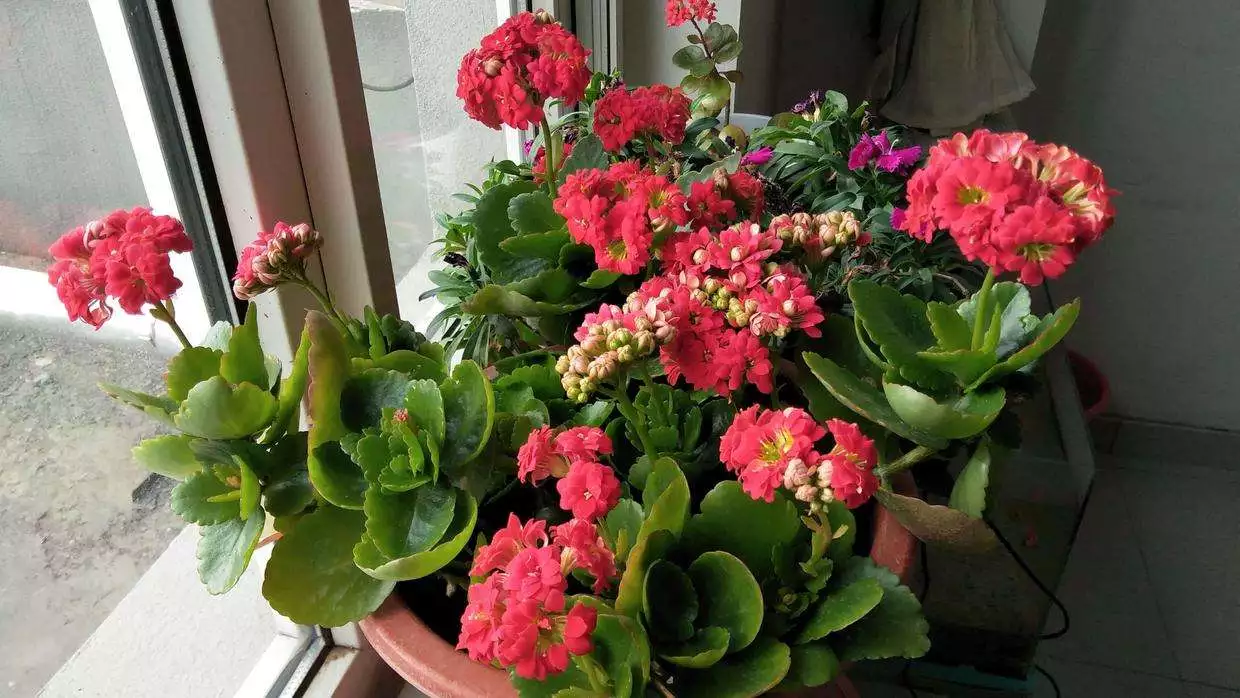How To Grow And Care For Flaming Katy (Kalanchoe Blossfeldiana)
Written by Ivy
Dec 21 2021

Flaming Katy (Kalanchoe Blossfeldiana) is an ideal indoor cultured flower in winter and spring. Flaming Katy is a small plant with compact plant type, green leaves and dense flowers. It has the meaning of good luck and long life. It is an ideal potted flower for relatives, friends and elders. What should we pay attention to the maintenance of flaming Katy? Today, I'd like to introduce how to grow and care for flaming Katy.

The interval between two watering is different in different seasons. The spring and Autumn period is about three days. Summer is about five days (because of the high humidity, the interior of the soil does not necessarily dry quickly, so the interval is generally slightly longer than that in spring and Autumn). Winter is usually once a week. The temperature can affect whether watering is needed. If it is higher than 35 degrees in summer and lower than 8 degrees in winter, watering flaming Katy should be stopped.
Therefore, under the condition of sufficient light, the color of flaming Katy leaves will become lighter and red edges will appear. Flaming Katy's flowers are slightly larger and the color is more bright, but the color will slowly fade. If we want flag Katy to have a longer flowering period and more colorful flowers, it is better to place it in a bright place after the bud is opened.
For the base fertilizer of flaming Katy, we can choose slow-release fertilizer, which can play a role slowly. Foliar fertilizer can be used for topdressing in the growth period. In addition, phosphorus fertilizer, such as potassium dihydrogen phosphate, is mainly supplemented during the flowering period of flaming Katy.
Slow release fertilizer can be buried in the soil, so that it will slowly exert its own effect, and generally no fertilizer damage will occur. The foliar fertilizer used in topdressing can be directly sprayed on the surface of the leaves to make the flag Katy leaves look more shiny and better. When using potassium dihydrogen phosphate, pay attention to the concentration, which can be about one thousandth.
The frequency of fertilization also needs to be controlled. Flaming Katy can change soil once every two years, and slow-release fertilizer is applied at this time. Flaming Katy's foliar fertilizer can be used once every two weeks. Flaming Katy uses potassium dihydrogen phosphate once a week until flowering.
How do you trim flaming Katy? We just need to cut off from the base of the remnant flower, and only keep the two leaves of the flower stem, so that flaming Katy can better germinate new branches and bloom more next year.
After cutting the flower stems of flaming Katy, trim some yellow and rotten leaves, and trim some old leaves at the bottom, otherwise it will easily affect the photosynthesis of the new branches below, which is not conducive to the growth of new branches of flaming Katy.
The trimmed flower stems of flaming Katy can't be wasted. We can cut off the residual flowers and leave a pair of leaves, and then air them. We can survive by inserting them into the soil.
Just after summer, you can also change the pots for flaming Katy in autumn. If you don't change the pots in spring, autumn is the best choice. The nutrients in the pot soil are insufficient. If you change the pots, you can change the nutrients for flaming Katy, so that its roots can grow rapidly in the pot soil and absorb the nutrients in the pot soil. Autumn is the season for it to breed flower buds, After changing the pot, the root system grows rapidly, grows new buds, and then directly comes out to blossom. The new soil has sufficient nutrients, and the flower buds can expand and open quickly after they grow. If we find that flaming Katy has rotten roots or rotten leaves, we must change it in time.
When changing the basin for flaming Katy, whether in the growing season or after flowering, we must remember that we can't wash the roots and change the basin. Most of the roots of flaming Katy are capillary roots. After changing the basin, the roots are seriously damaged, which will easily lead to its failure to recover. How can we change the basin for it? When we change the basin for flaming Katy, we remove most of the soil and keep the protective soil in the middle. When we see that most of the root systems are exposed, we change the basin for flaming Katy. When we change the basin, we try to configure the soil similar to its original soil. After that, we pour water through it. When pouring water, add some carbendazim rooting solution and put it in a place with good scattered light and ventilation, Let it grow slowly and gradually grow new roots, which proves that flaming Katy's pot change is successful.
Treatment: we can use carbendazim, chlorothalonil or methyl tozin powder, according to 1:200 to prepare water solution, pour into the flowerpot, or spray the pot to spray the positive and negative sides of the leaf, three days to five days, and after three times, it can be cured. If flaming Katy is seriously ill, we can dig it out, wash it gently with water, wash the soil mass at the root, soak it in the prepared aqueous solution for 2-3 hours, then change the basin, change the soil, plant it again, and pour it through with the soaked aqueous solution. After changing the basin, flaming Katy should often spray the front and back of the leaves with the prepared aqueous solution, which can be cured after more than half a month. In spring and autumn, let the victim flaming Katy receive more sunlight, which can also increase the plant resistance, promote the absorption of liquid medicine and recover health faster.
In this case, we must not worry. As long as we observe more and find the disease in time, we can cut it more than 1-2 cm away from the blackened part of the root, mix it with carbendazim, chlorothalonil or methyltobuzin powder, soak the branches in the aqueous solution prepared at 1:200 for 2-3 hours, and then re cuttage with plain sand or vermiculite. The management is the same as above.
On the one hand, the treatment method is to cut off some flaming Katy branches, remove the diseased leaves, and then soak the branches with carbendazim aqueous solution for about 5-6 hours for sterilization. On the other hand, the original roots must be abandoned and the original pots and substrates must be sterilized; Then, the sterilized branches are re cutted into plain sand or vermiculite to excessively promote the root, which can take root in about ten days, and in about twenty days, when the root grows to 1 ~ 2 cm long, It can be planted in nutrient soil (peat soil + perlite are prepared in a ratio of 1:1, or a small amount of vermiculite can be added); finally, we should put flag Katy in a place with moderate temperature and good ventilation to slow down the seedlings. After the leaves are in good spirits, we can move them to astigmatism for maintenance, and we can take full-time light until new leaves come out (we should avoid full-time light in summer, which will burn the flag Katy leaves).
We can treat it with potassium permanganate aqueous solution, but it is only limited to the initial stage. If the powdery mildew is serious, sulfur powder is recommended. Make sulfur powder into a paste with water, apply it to the damaged flag Katy leaves and stems with a soft brush, and sprinkle some sulfur powder on the surface of the substrate in combination with watering to promote root absorption.
Flaming Katy Quick InfoFlaming Katy Care in DetailFlaming Katy WateringFlaming Katy SoilFlaming Katy lightFlaming Katy TemperatureFlaming Katy HumidityFlaming Katy FertilizerFlaming Katy PruningFlaming Katy RepottingFlaming Katy Pest & Disease CotrolFlaming Katy PropagationFlaming Katy Benefits
Flaming Katy Quick Info
| Botanical/Scientific Name | Kalanchoe Blossfeldiana |
| Common Name | Flaming Katy |
| When to Grow/Bloom/Harvest | Flower buds will appear in about 6-8 weeks |
| Uses | Interior plant |
| Origin | Madagascar |
| Light Care | Bright light to full sun |
| Soil Care | Drainage soil |
| Temperature Care | 65 to 70 F. (18-21 C.) |
| Humidity Care | 40-50% relative humidity |
| Watering | Apply water from the base of the plant |
| Pruning Care | Prune a leggy Flaming Katy |
| Fertilizer Care | Fertilize monthly with a diluted flowering plant food |
| Propagation | Stem cuttings or leaf cuttings |
| Toxic | Highly poisonous when ingested |
Flaming Katy Care in Detail

Flaming Katy Watering
Specifically, we can use the watering can and other tools to slowly pour along the edge of the flaming katy flowerpot. It is best not to splash on the leaves, especially the flaming Katy flowers. It is best not to pour directly down from the top of the plant, and do not use the "dip basin method". There is a simple way to judge whether flaming Katy needs watering. You can insert them into the soil with the help of common tools around you, such as bamboo sticks and small wooden sticks. Take it out after a while. If there is moisture on it, flaming Katy needs watering.The interval between two watering is different in different seasons. The spring and Autumn period is about three days. Summer is about five days (because of the high humidity, the interior of the soil does not necessarily dry quickly, so the interval is generally slightly longer than that in spring and Autumn). Winter is usually once a week. The temperature can affect whether watering is needed. If it is higher than 35 degrees in summer and lower than 8 degrees in winter, watering flaming Katy should be stopped.
Flaming Katy Soil
When planting flaming Katy, we should try to choose the soil with good drainage and air permeability. It is very important to have good drainage. Flaming Katy is a plant that is afraid of water logging. We can mix garden soil, coarse sand, cinder and rotten leaf soil. The prepared soil not only has good drainage, but also has very loose soil. It is very suitable for the growth of flaming Katy and is very good for its roots.Flaming Katy light
Generally, flowering plants are inseparable from light. Light promotes flower bud differentiation and makes the flower color more gorgeous. The lack of light affects flowering, and the flower color will be dimmer. Flaming Katy is a plant that cannot lack light. In addition to avoiding strong light exposure when the flowers are in full bloom, it can be cultivated in a sunny environment for the rest of the time, even in summer.Therefore, under the condition of sufficient light, the color of flaming Katy leaves will become lighter and red edges will appear. Flaming Katy's flowers are slightly larger and the color is more bright, but the color will slowly fade. If we want flag Katy to have a longer flowering period and more colorful flowers, it is better to place it in a bright place after the bud is opened.
Flaming Katy Temperature
The suitable temperature for flaming Katy's growth is 15 ~ 25 ℃. If the high temperature exceeds 30 ℃ in summer, the growth is blocked, and the indoor temperature in winter is 12 ~ 15 ℃. Below 5 ℃, the leaves turn red, and the flowering of flaming Katy is delayed. In winter and spring, if the room temperature exceeds 24 ℃, flowering will be inhibited. If the temperature of flaming Katy is about 15 ℃, flaming Katy will bloom continuously.
Flaming Katy Humidity
We often keep flaming Katy slightly moist in spring and autumn. It is better to water less in summer and once every 5 ~ 7 days. After entering the room in winter, water close to the room temperature should be poured once a week. Flaming Katy has compact plant type, thick and shiny leaves, petite and beautiful flower shape, long flowering period and high ornamental value. Flaming Katy can absorb carbon dioxide at night and release oxygen to make the indoor air fresh and natural. And flaming Katy's leaves can accumulate moisture and effectively regulate indoor air humidity.Flaming Katy Fertilizer
Flaming Katy's root system is not very developed, so it has poor tolerance to fertilizer. It can be applied with appropriate amount at ordinary times. When changing soil, you can use an appropriate amount of base fertilizer. In normal growth period, topdressing can be used, and some additional fertilizer must be used in flowering period.For the base fertilizer of flaming Katy, we can choose slow-release fertilizer, which can play a role slowly. Foliar fertilizer can be used for topdressing in the growth period. In addition, phosphorus fertilizer, such as potassium dihydrogen phosphate, is mainly supplemented during the flowering period of flaming Katy.
Slow release fertilizer can be buried in the soil, so that it will slowly exert its own effect, and generally no fertilizer damage will occur. The foliar fertilizer used in topdressing can be directly sprayed on the surface of the leaves to make the flag Katy leaves look more shiny and better. When using potassium dihydrogen phosphate, pay attention to the concentration, which can be about one thousandth.
The frequency of fertilization also needs to be controlled. Flaming Katy can change soil once every two years, and slow-release fertilizer is applied at this time. Flaming Katy's foliar fertilizer can be used once every two weeks. Flaming Katy uses potassium dihydrogen phosphate once a week until flowering.
Flaming Katy Pruning
When flaming Katy fails, we will conduct a systematic pruning for flaming Katy. Of course, the residual flowers that fail during flowering should also be pruned in time, otherwise it will not only affect the beauty, but also waste nutrition.How do you trim flaming Katy? We just need to cut off from the base of the remnant flower, and only keep the two leaves of the flower stem, so that flaming Katy can better germinate new branches and bloom more next year.
After cutting the flower stems of flaming Katy, trim some yellow and rotten leaves, and trim some old leaves at the bottom, otherwise it will easily affect the photosynthesis of the new branches below, which is not conducive to the growth of new branches of flaming Katy.
The trimmed flower stems of flaming Katy can't be wasted. We can cut off the residual flowers and leave a pair of leaves, and then air them. We can survive by inserting them into the soil.

Flaming Katy Repotting
The best time for us to repot flaming Katy is after flowering and in the season of rapid growth, that is, spring and autumn. In summer, it is hot and stuffy, and there is no ventilation. Flaming Katy grows slowly and even sleeps. If you change the pots for flaming Katy, it is easy to have rotten roots and leaves due to improper operation, and the temperature is low in winter, The growth is relatively slow, but it is the flowering period of flaming Katy. Damaging the root during flowering will weaken the absorption function of the root, affect its flowering, and even drop the flower bud. The flower bud is dry and falls off. Therefore, the best season is in spring after flowering.Just after summer, you can also change the pots for flaming Katy in autumn. If you don't change the pots in spring, autumn is the best choice. The nutrients in the pot soil are insufficient. If you change the pots, you can change the nutrients for flaming Katy, so that its roots can grow rapidly in the pot soil and absorb the nutrients in the pot soil. Autumn is the season for it to breed flower buds, After changing the pot, the root system grows rapidly, grows new buds, and then directly comes out to blossom. The new soil has sufficient nutrients, and the flower buds can expand and open quickly after they grow. If we find that flaming Katy has rotten roots or rotten leaves, we must change it in time.
When changing the basin for flaming Katy, whether in the growing season or after flowering, we must remember that we can't wash the roots and change the basin. Most of the roots of flaming Katy are capillary roots. After changing the basin, the roots are seriously damaged, which will easily lead to its failure to recover. How can we change the basin for it? When we change the basin for flaming Katy, we remove most of the soil and keep the protective soil in the middle. When we see that most of the root systems are exposed, we change the basin for flaming Katy. When we change the basin, we try to configure the soil similar to its original soil. After that, we pour water through it. When pouring water, add some carbendazim rooting solution and put it in a place with good scattered light and ventilation, Let it grow slowly and gradually grow new roots, which proves that flaming Katy's pot change is successful.
Flaming Katy Pest & Disease Cotrol
- Leaf Spot
Treatment: we can use carbendazim, chlorothalonil or methyl tozin powder, according to 1:200 to prepare water solution, pour into the flowerpot, or spray the pot to spray the positive and negative sides of the leaf, three days to five days, and after three times, it can be cured. If flaming Katy is seriously ill, we can dig it out, wash it gently with water, wash the soil mass at the root, soak it in the prepared aqueous solution for 2-3 hours, then change the basin, change the soil, plant it again, and pour it through with the soaked aqueous solution. After changing the basin, flaming Katy should often spray the front and back of the leaves with the prepared aqueous solution, which can be cured after more than half a month. In spring and autumn, let the victim flaming Katy receive more sunlight, which can also increase the plant resistance, promote the absorption of liquid medicine and recover health faster.
- Black Rot
In this case, we must not worry. As long as we observe more and find the disease in time, we can cut it more than 1-2 cm away from the blackened part of the root, mix it with carbendazim, chlorothalonil or methyltobuzin powder, soak the branches in the aqueous solution prepared at 1:200 for 2-3 hours, and then re cuttage with plain sand or vermiculite. The management is the same as above.
- Mosaic Virus
On the one hand, the treatment method is to cut off some flaming Katy branches, remove the diseased leaves, and then soak the branches with carbendazim aqueous solution for about 5-6 hours for sterilization. On the other hand, the original roots must be abandoned and the original pots and substrates must be sterilized; Then, the sterilized branches are re cutted into plain sand or vermiculite to excessively promote the root, which can take root in about ten days, and in about twenty days, when the root grows to 1 ~ 2 cm long, It can be planted in nutrient soil (peat soil + perlite are prepared in a ratio of 1:1, or a small amount of vermiculite can be added); finally, we should put flag Katy in a place with moderate temperature and good ventilation to slow down the seedlings. After the leaves are in good spirits, we can move them to astigmatism for maintenance, and we can take full-time light until new leaves come out (we should avoid full-time light in summer, which will burn the flag Katy leaves).
- Powdery Mildew
We can treat it with potassium permanganate aqueous solution, but it is only limited to the initial stage. If the powdery mildew is serious, sulfur powder is recommended. Make sulfur powder into a paste with water, apply it to the damaged flag Katy leaves and stems with a soft brush, and sprinkle some sulfur powder on the surface of the substrate in combination with watering to promote root absorption.

Flaming Katy Propagation
- Flaming Katy Branch Cutting
- Flaming Katy Stem Cutting
- Flaming Katy Topping Cutting
- Flaming Katy Layering
- Flaming Katy Propagated in water
Flaming Katy Benefits
- Beautify the environment
- Clean air
- As a gift
Latest Updated
- Benefits of Bugleweed - 7 Science-backed Health Benefits
- Bugleweed Dangers & Side Effects - Is It Poisonous?
- How to Plant Evergreen Trees - What You Should Know
- When to Plant Evergreens - Grow Guide for Evergreen Trees
- 12 Wonderful Evergreen Shrubs for Your Garden
- 12 Popular Evergreen Plants with Pictures for Beginners
- When And How To Prune A Lilac Bush Like a Pro
- How to Grow & Care for Lilac Vine (Hardenbergia Violacea)
- Japanese Lilac Tree (Syringa Reticulata) Care & Propagation Guide
- Shumard Oak Pros and Cons - What to Know
Popular Articles
- Winter maintenance of Antirrhinum Majus
- How to Grow Terminalia Mantaly Tree
- How to Grow and Care for Crossostephium Chinense
- How to grow Antirrhinum Majus in spring
- Peristeria Elata (Dove Orchid) Profile: Info & Care Guide
- Underwatered Snake Plant (Sansevieria Trifasciata) - Signs And How To Fix
- How to Care for Brazilian Jasmine Plant (Mandevilla Sanderi)
- How to Grow & Care for Graptopetalum Purple Delight in Summer
- Rosa Chinensis (China Rose): Plant Growing & Care Tips
- How to Care for Baby Sun Rose (Aptenia Cordifolia)